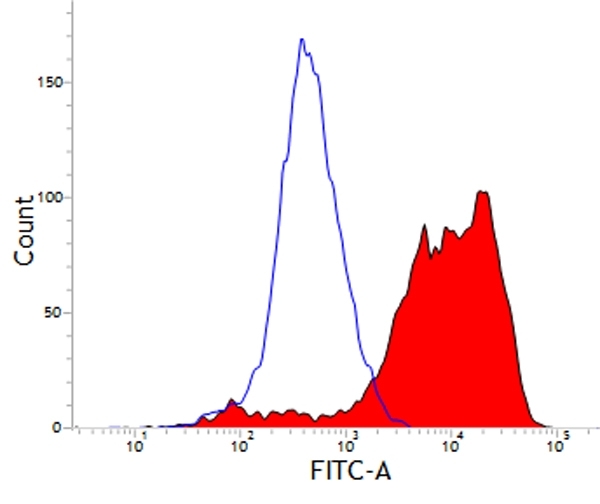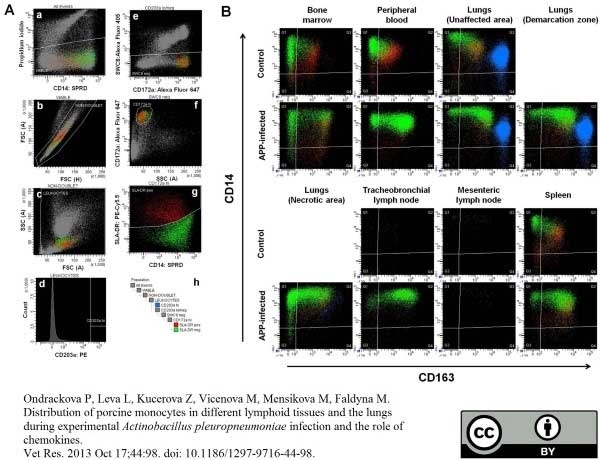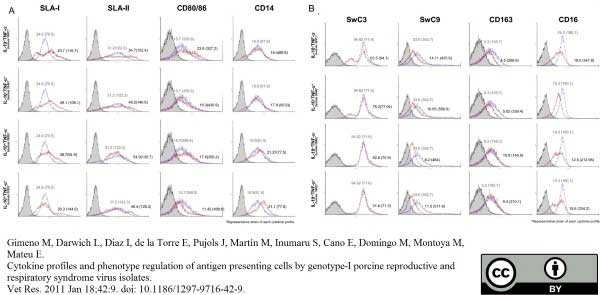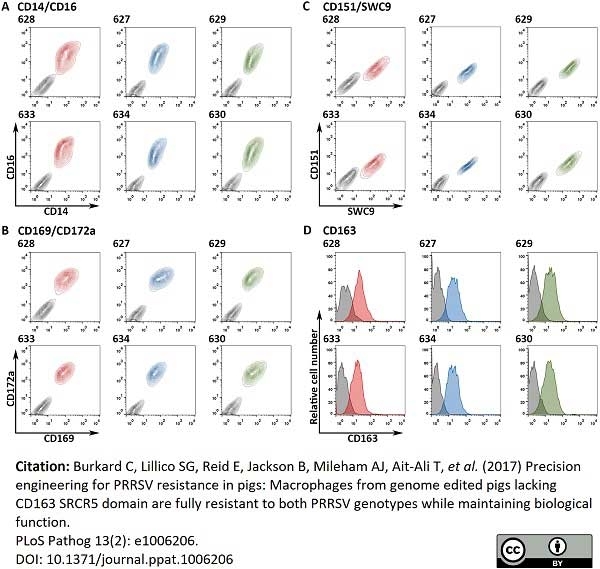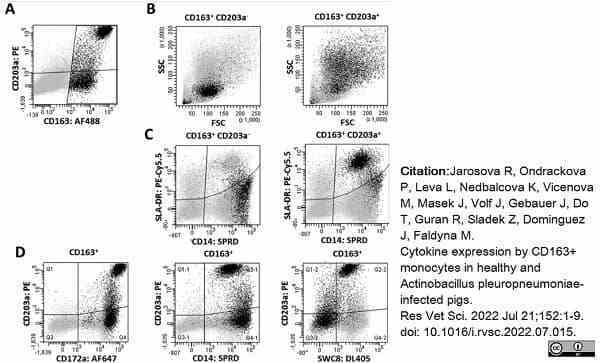CD203a antibody | PM18-7





Mouse anti Pig CD203a
- Product Type
- Monoclonal Antibody
- Clone
- PM18-7
- Isotype
- IgG1
- Specificity
- CD203a
| Mouse anti Pig CD203a, clone PM18-7 recognizes porcine CD203a, originally clustered as SWC9 at the Second International Swine CD Workshop (Dominguez et al. 1998) and later identified as the porcine homologue of human ecto-nucleotidepyrophosphatase / phosphodiesterase 1 or ENPP1 (Petersen et al. 2007). Mouse anti Pig CD203a was originally reported to immunoprecipitate two bands, one of ~;205 kDa and one of ~130 kDa (Dominguez et al. 1998) under both reducing and non-reducing conditions. CD203a migrates as a homodimer of ~260 kDa under non-reducing conditions and a 130 kDa monomer under reducing conditions (Petersen et al. 2007) from preparations of porcine alveolar macrophages. CD203a is expressed widely in macrophage populations with notably high levels on alveolar macrophages (Petersen et al. 2007, Hwang et al. 2015), it is not expressed on monocyte populations (McCullough et al. 1997, Hwang et al. 2015). SWC1a, expressed at very much higher levels on monocytes than mature macrophages and CD203a (SWC9), expressed exclusively on mature tissue macrophages have been used as markers of monocyte-macrophage differentiation (Sanchez et al. 1999). |
- Target Species
- Pig
- Product Form
- Purified IgG - liquid
- Preparation
- Purified IgG prepared by affinity chromatography on Protein A from tissue culture supernatant
- Buffer Solution
- Phosphate buffered saline
- Preservative Stabilisers
- 0.09% sodium azide (NaN3)
- Carrier Free
- Yes
- Immunogen
- Porcine alveolar macrophages.
- Approx. Protein Concentrations
- IgG concentration 1.0 mg/ml
- Fusion Partners
- Spleen cells from immunized mice were fused with P3X63-Ag8-653 murine myeloma cells (Kearney et al. 1979).
- Regulatory
- For research purposes only
- Guarantee
- 12 months from date of despatch
Avoid repeated freezing and thawing as this may denature the antibody. Storage in frost-free freezers is not recommended.
| Application Name | Verified | Min Dilution | Max Dilution |
|---|---|---|---|
| Flow Cytometry | 1/25 | 1/200 | |
| Immunohistology - Frozen | |||
| Immunoprecipitation |
- Flow Cytometry
- Use 10μl of the suggested working dilution to label 1x106 cells in 100μl
| Description | Product Code | Applications | Pack Size | List Price | Your Price | Quantity | |
|---|---|---|---|---|---|---|---|
| Mouse IgG1 Negative Control | MCA928 | F | 100 Tests |
|
Log in | ||
| List Price | Your Price | ||||||
|
|
Log in | ||||||
| Description | Mouse IgG1 Negative Control | ||||||
References for CD203a antibody
-
McCullough, K.C. et al. (1997) Phenotype of porcine monocytic cells: modulation of surface molecule expression upon monocyte differentiation into macrophages.
Vet Immunol Immunopathol. 58 (3-4): 265-75. -
Dominguez, J. et al. (1998) Workshop studies with monoclonal antibodies identifying a novel porcine differentiation antigen, SWC9.
Vet Immunol Immunopathol. 60 (3-4): 343-9. -
Domínguez, J. et al. (1998) Porcine myelomonocytic markers: summary of the Second International Swine CD Workshop.
Vet Immunol Immunopathol. 60 (3-4): 329-41. -
Sánchez, C. et al. (1999) The porcine 2A10 antigen is homologous to human CD163 and related to macrophage differentiation.
J Immunol. 162 (9): 5230-7. -
Basta, S. et al. (1999) Modulation of monocytic cell activity and virus susceptibility during differentiation into macrophages.
J Immunol. 162 (7): 3961-9. -
Basta, S. et al. (2001) Lipopolysaccharide and phorbol 12-myristate 13-acetate both impair monocyte differentiation, relating cellular function to virus susceptibility.
Immunology. 103 (4): 488-97. -
Boersma, W.J. et al. (2001) Summary of workshop findings for porcine B-cell markers.
Vet Immunol Immunopathol. 80 (1-2): 63-78. -
Cantu, E. et al. (2006) Depletion of pulmonary intravascular macrophages prevents hyperacute pulmonary xenograft dysfunction.
Transplantation. 81 (8): 1157-64.
View The Latest Product References
-
Petersen, C.B. et al. (2007) Porcine ecto-nucleotide pyrophosphatase/phosphodiesterase 1 (NPP1/CD203a): cloning, transcription, expression, mapping, and identification of an NPP1/CD203a epitope for swine workshop cluster 9 (SWC9) monoclonal antibodies.
Dev Comp Immunol. 31 (6): 618-31. -
Gimeno, M. et al. (2011) Cytokine profiles and phenotype regulation of antigen presenting cells by genotype-I porcine reproductive and respiratory syndrome virus isolates.
Vet Res. 42: 9. -
Ondrackova, P. et al. (2013) Phenotypic characterisation of the monocyte subpopulations in healthy adult pigs and< i> Salmonella-infected piglets by seven-colour flow cytometry.
Res Vet Sci. 94: 240 - 5. -
Tsai, Y.C. et al. (2014) Differences in the expression of innate immune response-modulating genes in blood monocytes between subclinically porcine circovirus type s (PCV2)-infected and PCV2-free pigs prior to and after lipopolysaccharide stimulation in vitro
Taiwan Vet J. 40 (01): 37-48. -
Hwang, J.H.et al. (2015) Characterization of monoclonal antibodies against porcine pulmonary alveolar macrophages of gnotobiotic miniature swine.
Biochem Biophys Res Commun. 461 (2): 427-34. -
Shao, L. et al. (2016) Tissue-specific mRNA expression profiles of porcine Toll-like receptors at different ages in germ-free and conventional pigs.
Vet Immunol Immunopathol. 171: 7-16. -
Burkard, C. et al. (2017) Precision engineering for PRRSV resistance in pigs: Macrophages from genome edited pigs lacking CD163 SRCR5 domain are fully resistant to both PRRSV genotypes while maintaining biological function.
PLoS Pathog. 13 (2): e1006206. -
Fernández-Caballero, T. et al. (2018) Phenotypic and functional characterization of porcine bone marrow monocyte subsets.
Dev Comp Immunol. 81: 95-104. -
Sautter, C.A. et al. (2018) Phenotypic and functional modulations of porcine macrophages by interferons and interleukin-4.
Dev Comp Immunol. 84: 181-92. -
Zimmermann, C.E. et al. (2021) Characterization of porcine mesenchymal stromal cells and their proliferative and osteogenic potential in long-term culture.
J Stem Cells Regen Med. 17 (2): 49-55. -
Jarosova, R. et al. (2022) Cytokine expression by CD163+ monocytes in healthy and Actinobacillus pleuropneumoniae.-infected pigs.
Res Vet Sci. 152: 1-9. -
Petitpas, K. et al. (2022) Genetic modifications designed for xenotransplantation attenuate sialoadhesin-dependent binding of human erythrocytes to porcine macrophages.
Xenotransplantation. 29 (6): e12780. -
Álvarez, B. et al. (2023) Porcine Macrophage Markers and Populations: An Update.
Cells. 12 (16): 2103. -
Nieto-Pelegrín, E. et al. (2020) Porcine CLEC12B is expressed on alveolar macrophages and blood dendritic cells.
Dev Comp Immunol. 111: 103767.
Further Reading
-
Piriou-Guzylack, L. & Salmon, H. (2008) Membrane markers of the immune cells in swine: an update.
Vet Res. 39 (6): 54.
- Synonyms
- SWC9
MCA1973GA
If you cannot find the batch/lot you are looking for please contact our technical support team for assistance.
Please Note: All Products are "FOR RESEARCH PURPOSES ONLY"
View all Anti-Pig ProductsAlways be the first to know.
When we launch new products and resources to help you achieve more in the lab.
Yes, sign me up